
A synagogue, also called a shul or a temple, is a place of worship for Jews and Samaritans. It has a place for prayer where Jews attend religious services or special ceremonies such as weddings, bar and bat mitzvahs, choir performances, and children's plays. They also have rooms for study, social halls, administrative and charitable offices, classrooms for religious and Hebrew studies, and many places to sit and congregate. They often display commemorative, historic, or modern artwork alongside items of Jewish historical significance or history about the synagogue itself.

Livorno is a port city on the Ligurian Sea on the western coast of the Tuscany region, Italy. It is the capital of the Province of Livorno, having a population of 158,493 residents in December 2017. It is traditionally known in English as Leghorn.

The Great Synagogue of Rome is the largest synagogue in Rome.

Synagogue architecture often follows styles in vogue at the place and time of construction. There is no set blueprint for synagogues and the architectural shapes and interior designs of synagogues vary greatly. According to tradition, the Shekhinah or divine presence can be found wherever there is a minyan, a quorum, of ten. A synagogue always contains an Torah ark where the Torah scrolls are kept, called the aron qodesh by Ashkenazi Jews and the hekhal by Sephardic Jews.
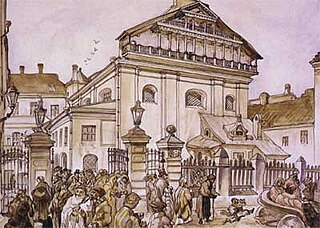
The Great Synagogue, officially, the Great City Synagogue in Vilna, also the Great Synagogue of Vilnius, is a former Orthodox Jewish congregation and synagogue, located atI-2 Jewish Street in the Old Town of Vilnius, in the Vilnius County of Lithuania.

The Kahal Shalom Synagogue is an Orthodox Jewish congregation and synagogue, located in La Juderia, the Jewish quarter of the city of Rhodes on the island of Rhodes, in the South Aegean region of Greece. Completed in 1577, the synagogue building is the oldest synagogue in Greece. The congregation worships in the Eastern Sephardi rite, predominately in summer months only.

Tempel Synagogue was a Progressive Jewish synagogue, located at the Old Market Square 14 in Lviv, at the time part of the Austro-Hungarian Empire; and, since 1991, now in Ukraine. Lviv was one of the first Galician cities to have a modernized synagogue. The synagogue was destroyed by Nazi Germany in 1941, following Operation Barbarossa.

The Spanish Synagogue is a former Conservative Jewish synagogue, located in the area of the so-called Jewish Town, Prague, in the Czech Republic. The synagogue was completed in 1868 in the Moorish Revival style on the site of the presumably oldest synagogue, Old School. In 1955 the former synagogue was permanently repurposed as a Jewish museum and is administered by the Jewish Museum in Prague.

The Włodawa Synagogue is a former Orthodox Jewish congregation and synagogue complex, located at 5-7 Czerwonego Krzyża Street, in Włodawa, in the Lublin Voivodeship of Poland. The synagogue complex comprises the Włodawa Great Synagogue, the Small Synagogue or Beit midrash, and a Jewish administrative building, all now preserved as a Jewish museum.

The Przedbórz Synagogue was a former Orthodox Jewish congregation and synagogue, that was located at the southeastern corner of the Main Square, at the intersection of today's Giełczyńska and Senatorska Streets, in Przedbórz, in the Łódź Voivodeship of Poland. Designed as a wooden synagogue and completed in 1889, the synagogue served as a house of prayer until World War II when it was destroyed by Nazis in 1939.
The Biella Synagogue is a Jewish congregation and synagogue, that is located at Vicolo del Bellone 3, in Biella, Piedmont, Italy. The synagogue was completed in 1780.
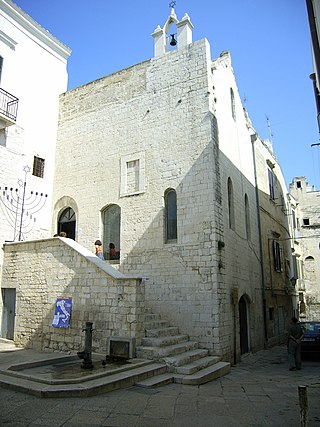
The Scolanova Synagogue is a Jewish congregation and synagogue, located at Via Sinagoga 47, in the town of Trani, Puglia in Italy. Built by the Italian–Jewish community of Apulia during the Middle Ages, the building was acquired by the Roman Catholic Church in 1380 during a wave of antisemitism and served as St. Maria's Church until it was deconsecrated and returned to the Jewish community in 2006.

The Scolagrande Synagogue is a Jewish congregation and synagogue, located at Via la Giudea 24, in the town of Trani, Puglia in Italy. Built by the Italian–Jewish community of Apulia during the Middle Ages and completed in 1247, the building was acquired by the Roman Catholic Church in 1380 and served as St. Anne's Church until it was deconsecrated and returned to the Jewish community in 2004.
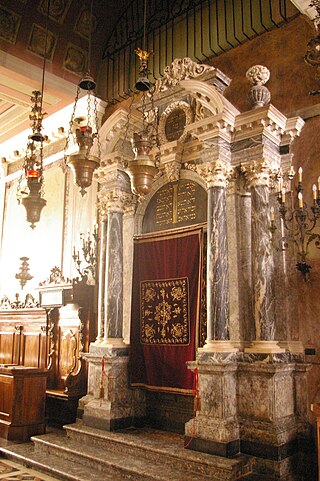
The Padua Synagogue, also called the Great Italian Synagogue in Padua, is an Orthodox Jewish congregation and synagogue, that is located at San Martino e Solferino 9, in Padua, Veneto, Italy. Completed in 1548, it is the only synagogue still in use of the several that flourished in the university town of Padua from the Renaissance through World War II.
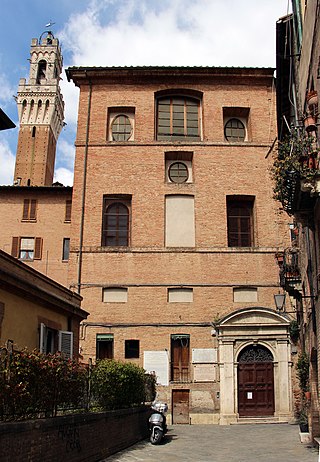
The Siena Synagogue is a notable, historic Orthodox Jewish congregation and synagogue, located at via delle Scotte 14, in Siena, Tuscany, Italy. The building also houses the Jewish Museum of Siena, a Jewish museum. Designed by Giuseppe del Rosso in the Neoclassical style with extensive Rococo features, the synagogue was completed in May 1786.

The Canton Synagogue is a former Orthodox Jewish congregation and synagogue, that is located in the Jewish Ghetto of Venice, Italy.
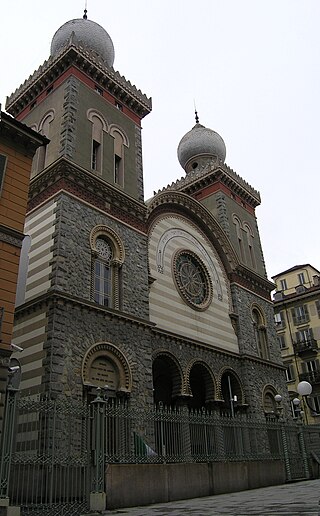
The Synagogue of Turin, also known as Israelite Temple, is a Jewish congregation and synagogue, that is located at 12 Via Pio V, in Trieste, Piedmont, Italy. Designed by Enrico Petiti in the Moorish Revival style, the synagogue was completed in 1884.

The Great German Synagogue is a former Orthodox Jewish congregation and synagogue, that is located in the Jewish Ghetto of Venice, Italy. Completed in 1528, it is the oldest Venetian synagogue, and one of five synagogues that were established in the ghetto.

The Viareggio Synagogue is a Jewish congregation and synagogue, located at via delgi Oleandri 30, in Viareggio, in the Province of Lucca, Tuscany, Italy. The congregation is administered by the Jewish Community of Pisa.

The Rijeka Orthodox Synagogue is an Orthodox Jewish synagogue, located on Ivan Filipović Street, formerly Galvani Street, in Rijeka in Croatia. The synagogue was built in a Rationalist style in 1931. It is one of the very few synagogues in Croatian territory to have survived the destruction of the Nazi period.





















